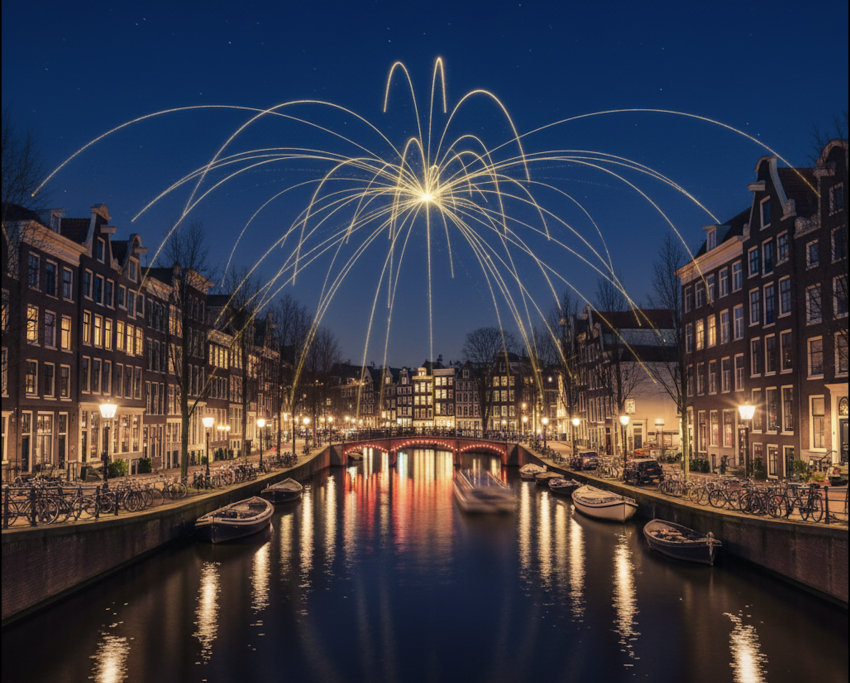In Europe’s digital map, there’s a single point where everything converges. It’s the place where fiber from London, Frankfurt, and the Nordics meets transatlantic cables from the U.S. and Asia. It’s where the regulatory framework is more liberal – and more advanced – than anywhere else in the world. That place is Amsterdam.
For companies building or owning infrastructure here, this convergence delivers the best possible electrical, physical, regulatory, financial, and legal conditions. It’s widely known within the industry that an Amsterdam data center is the natural home for high-performance systems.
This is why, 23 years ago, Advanced Hosting chose Amsterdam as its core location.
Where the Internet Rooted Itself in Europe
Let’s start with a bit of history.
Long before the web turned into what it is today – a global industry – Europe’s digital story began in the Venice of the North.
On November 17, 1988, researchers at the city’s Centrum Wiskunde & Informatica (CWI) established the first non-military, trans-Atlantic internet connection – linking the Netherlands directly to the U.S. and making it the first European nation connected to the public internet.
That single event made Amsterdam the continent’s original digital gateway. From there, the foundations of Europe’s online infrastructure were laid: the first country-code top-level domain, .NL, was registered here, and the early DNS root servers that shaped today’s domain system were hosted on the same campus.
At first, it was a purely academic experiment. But it quickly evolved into an international network business. The early exchange points at CWI grew into what we now know as AMS-IX (Amsterdam Internet Exchange). It’s one of the largest and most densely interconnected IXPs on the planet. AMS-IX processes terabits per second of peering traffic. It’s the routing core of the entire Europe.
A Truly Advanced Network: Inside Amsterdam Data Centers
Every major digital route in Europe passes through Amsterdam. It’s the continent’s optical intersection, where long-haul fiber from Asia, the Nordics, and North America all meet, exchange, and redistribute traffic across the European mainland.
To visualize it: traffic entering Europe from the transatlantic cables between the U.S. and the Netherlands lands on the Dutch coast before branching out through Amsterdam’s carrier hotels and major Netherlands data centers.
It’s a literal mesh – short-haul terrestrial fibers layered over transoceanic backbones – and Amsterdam sits exactly at the center of that architecture.
This intersection makes the city unique in three critical ways:
- Lowest Average Latency in Europe – Because routes terminate and exchange locally, packets between Amsterdam and any major European capital travel in single-digit milliseconds.
- Maximum Carrier Diversity – Hundreds of independent carriers, IXPs, and CDNs operate within a few square kilometers, each providing distinct routes, optical wavelengths, and SLAs, which clients can choose from.
- Route Redundancy by Design – No single carrier dominates the network. Even if one path is disrupted, alternative routes are immediately available through separate physical conduits and switching nodes.
That combination – low latency, diversity, and redundancy – defines the business logic behind Amsterdam’s digital economy.
For platforms built on real-time performance – streaming, gaming, fintech, AI inference, edge analytics – milliseconds translate directly into engagement and revenue.
- When a video starts instantly, users stay longer.
- When a trading algorithm executes a few milliseconds faster, portfolios grow.
- When a game server responds without lag, retention curves flatten instead of falling.
This is why Amsterdam is where network physics meets business performance. Equipped with its premium-tier connectivity options, businesses here can achieve higher retention, stronger ad delivery rates, and lower operational costs per transaction.
Ready to take full control of your infrastructure? Explore our custom solutions
A Liberal Framework That Powers Innovation in the Netherlands and the World at Large
Amsterdam’s rise as Europe’s digital capital didn’t happen by accident.
It was built on a legal and cultural foundation that treated technology not as a threat to regulate, but as a necessary and important force to accommodate.
For decades, the Netherlands has been a global leader in adopting a practical and sensible approach to digital regulation. The country’s legal framework is rooted in a long tradition of liberal, non-interventionist governance – an attitude shaped by centuries of global trade, maritime law, and open commerce. Those same principles migrated into the digital era.
When the early internet began to expand across Europe in the 1990s, Dutch policymakers adopted a rule that still forms the backbone of their regulatory landscape today:
if an activity is lawful, consent-based, and transparent, it can operate.
That governance model continues to protect Netherlands data centers, ensuring lawful neutrality and a consistent digital policy across the region.
And that clarity matters more than it might seem. While other European states built reactive, restrictive models – often merging regulation with moral considerations – the Netherlands built one around legal precision and predictability.
This predictability allowed Amsterdam to host everything from financial institutions and multinational enterprises to gaming platforms, media companies, and content-distribution networks that couldn’t easily operate elsewhere.
It gave rise to what many call Europe’s most mature digital jurisdiction – one where the rules are clear, enforcement is proportionate, and service providers aren’t punished for doing their jobs within the law.
This legal stability has been critical to Amsterdam’s evolution into Europe’s infrastructure hub.
It allowed early companies to build without fear of retroactive regulation and gave international players confidence that their investments would be protected by law, not politics.
The same mindset shaped Amsterdam’s approach to data sovereignty. Dutch authorities were among the first to recognize that infrastructure neutrality – the idea that networks themselves should remain impartial – is essential for an open digital economy.
Rather than pushing for strict localization or state control, the Netherlands aligned with EU data-protection standards while preserving operational flexibility for global businesses. This balance – liberal but lawful, regulated but not restrictive – is what keeps Amsterdam stable while other hubs fluctuate with political cycles.
Even industries that operate in riskier or more sensitive zones elsewhere – such as adult-content distribution, high-frequency gaming, or decentralized web services – can function here transparently, provided they comply with consent, taxation, and privacy standards.
This legal clarity is one of the hidden reasons the city remains so attractive to infrastructure owners, cloud operators, and digital platforms.
Our Amsterdam Infrastructure

Given all this, it’s no surprise that two decades ago we decided to anchor our footprint directly inside Amsterdam’s ecosystem. AMS-3, AMS-7, and AMS-17 – our three Amsterdam data centers – are all clustered within the Schiphol district. It’s literally a fifteen-minute walk between sites.
Inside that cluster, the three facilities form what we call our DWDM ring – a private, high-capacity optical loop interlinking every site. DWDM (Dense Wavelength Division Multiplexing) provides fully dedicated optical channels, isolated from the public internet, with latency under one millisecond between data centers. This design enables real-time replication, disaster recovery, and cross-site backups without ever leaving our private network.
If one route fails, traffic automatically flows in the opposite direction – the advantage of a true ring topology.
For clients, this means they can mirror storage or run failover nodes across separate facilities without performance loss or public exposure. It’s a private highway between our buildings – designed for redundancy.
Each data center connects to multiple upstream carriers through independent physical routes. No two providers share manholes or ducts; every fiber and power feed enters from a different side of the building.
All three facilities operate in Tier III-equivalent environments with N + 1 cooling, A + B power feeds, and dual substations supplying each site via separate paths. Power and connectivity are mirrored from the floor to the ceiling.
Inside, racks follow hot-/cold-aisle containment. Intake, exhaust, and under-floor pressure are continuously monitored; engineers can literally feel the balance in the air. Some rooms host GPU-dense racks drawing up to 16 kW each. Every sensor, breaker, and PDU is logged in our DCIM system, so nothing depends on memory or guesswork.
Operations in Amsterdam are deliberately vertical. Hardware preparation, cabling, remote hands, and a 24/7 NOC all sit under one operational roof. A failed drive, a new cross-connect, or a BGP change doesn’t bounce between vendors – it happens in-house, fast, and traceable.
Deploy your workloads on isolated, high-performance infrastructure in Amsterdam
Fort-Knox Level Security and Compliance
The security practices deserve special attention. Entry into our facilities runs through five independent layers:
- Checkpoint and ID verification with biometric registration.
- Mantrap corridor requiring simultaneous badge and fingerprint validation.
- Weight-check turnstile, locking automatically if mass differs by more than 300 grams on exit – a safeguard against hardware removal.
- Private cage access secured by a secondary fingerprint scan.
- CCTV coverage across every aisle and corridor, retained for 90 days and monitored around the clock.
Every access attempt – successful or denied – is logged in a central audit trail. No one enters or leaves unrecorded. The system is built for verifiable control, providing a foundation for creating infrastructure tailored to the specific regulatory demands of any industry.
Rationality as a Service Differentiator
Our operating philosophy mirrors Amsterdam’s own: lawful, tolerant, and non-judgmental.
Infrastructure is a technical space; our role is to provide capacity, not commentary. The rule is simple – if a client operates within the law, they have the right to run their business without interference.
In practice, that means we don’t rush to ban, censor, or abandon. We perform thorough due diligence on every prospect and never – ever – compromise on the law.
Every provider in our position faces complaints; the difference lies in how you respond. Across the industry, there are three models:
- The reactive host, which bans first and investigates later.
- The opaque host, which ignores everything – the so-called “abuse-resistant” operators who end up in raids and shutdowns.
- And the rational host – the one that verifies, documents, and acts based on evidence.
We belong firmly to the third group.
When a report arrives, we examine it line by line. In most cases, the complaint is misdirected – aimed at a redirector, cache, or unrelated domain.
We never ignore a report, but we don’t panic either. We trace the chain, confirm the origin, and – if the client isn’t at fault, which is almost always the case – close the matter without collateral damage.
That’s how lawful neutrality works in practice: we protect rights by verifying facts.
It’s the same principle that governs Amsterdam itself – transparent, predictable enforcement where what’s illegal is removed, and what’s lawful is left alone.
Conclusion: Why Building in an Amsterdam Data Center Makes Long-Term Sense
Amsterdam is Europe’s digital control room.
It’s where the internet first took root in Europe, where global traffic still converges, and where the laws that govern connectivity are defined by reason rather than reaction. In an age when the world is tightening controls, Amsterdam remains proof that openness still scales.
It’s the only place in Europe where global infrastructure and local rationality truly coexist.
For more than two decades, we’ve built within that system. Our infrastructure reflects the same principles that make Amsterdam work – precision in engineering, clarity in governance, and neutrality in judgment.
For companies that depend on performance, compliance, and predictability, there isn’t a better location in Europe than building their infrastructure within an Amsterdam data center. It makes long-term sense from every angle – technical, financial, and legal.
If these priorities describe your organization, explore Advanced Hosting’s Amsterdam-based infrastructure solutions. We partner with the world’s leading data centers to deliver custom, isolated environments – built to match your exact workloads, optimize performance, and reduce total cost of ownership.
